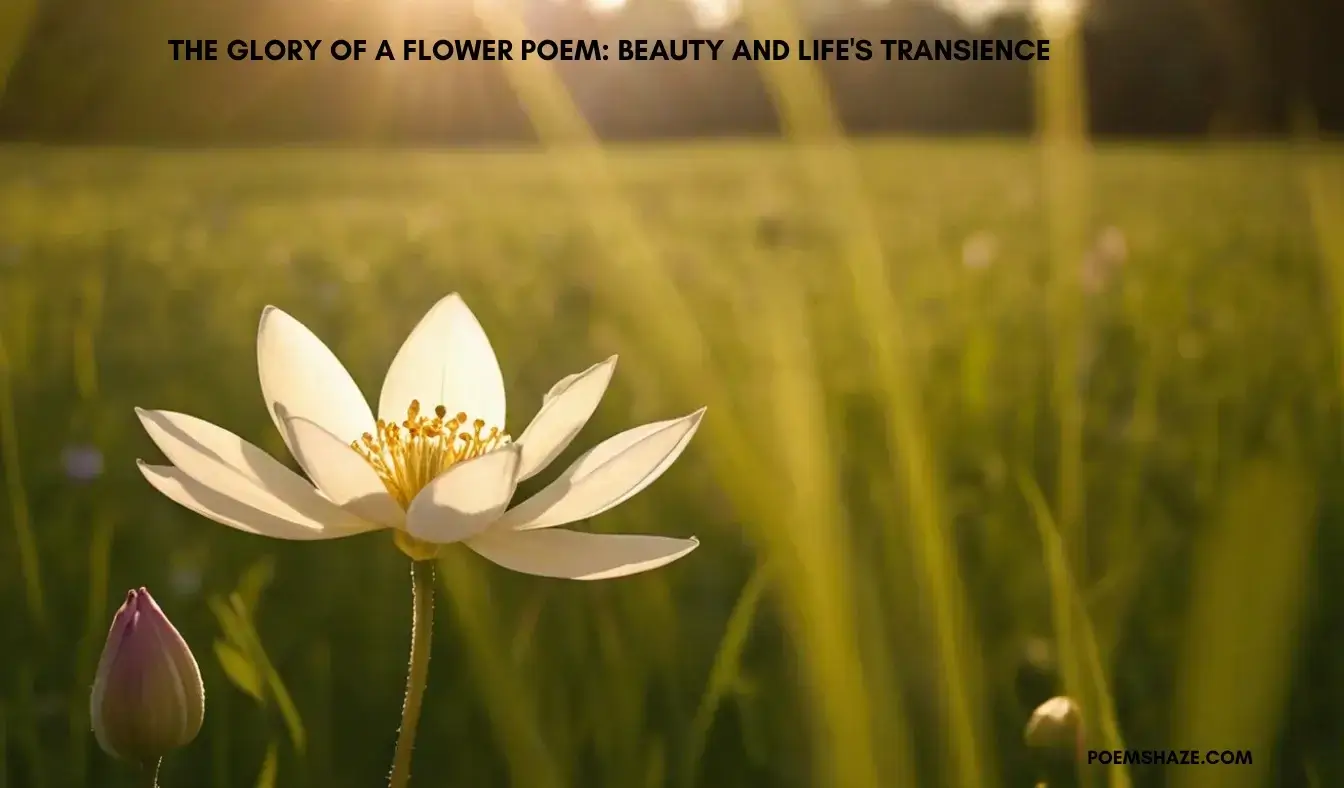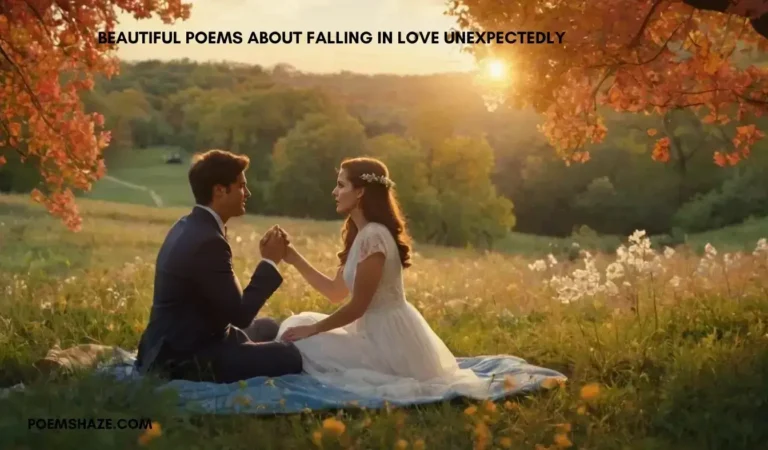The Glory of a Flower Poem: Beauty and Life’s Transience
The Glory of a Flower: A Celebration of Nature’s Impermanence
Flowers, with their delicate petals and vibrant colors, stand as a testament to the fleeting beauty of life. Each bloom whispers a profound truth: life is impermanent, but its moments hold infinite value. The glory of a flower lies not just in its appearance but in the message it conveys about growth, decay, and renewal.
In poetry, flowers symbolize both fragility and resilience, embodying the delicate balance between joy and sorrow. Their transience reflects the passage of time, reminding us to cherish the present moment. As they sway in the morning breeze, their subtle scent fills the air, igniting a sense of awe and wonder.
The symbolism of flowers extends beyond beauty. They remind us of the universal emotions shared in the human experience—from love and hope to the bittersweetness of loss. Poets often weave imagery and metaphors of blooming meadows and nature’s artistry to inspire readers to find beauty in the fleeting.
In celebrating the glory of the flower, we celebrate life itself—a reminder to embrace its impermanence and treasure every bloom along the way.
Poem 1: The Glory Within the Bloom
Beneath the sky so vast, serene,
A flower blooms, a fragile scene.
Its petals soft, in colors bright,
A fleeting beauty, pure delight.
It whispers truths of time and space,
Of life’s brief yet profound embrace.
The scent it shares upon the air,
Invites us all to pause, to care.
In morning light, it gently glows,
Through tender winds, its essence flows.
Its journey brief, from bud to fall,
A fleeting moment that holds it all.
Through growth and decay, renewal’s art,
The flower speaks to every heart.
To cherish love, to live each day,
Before the petals drift away.
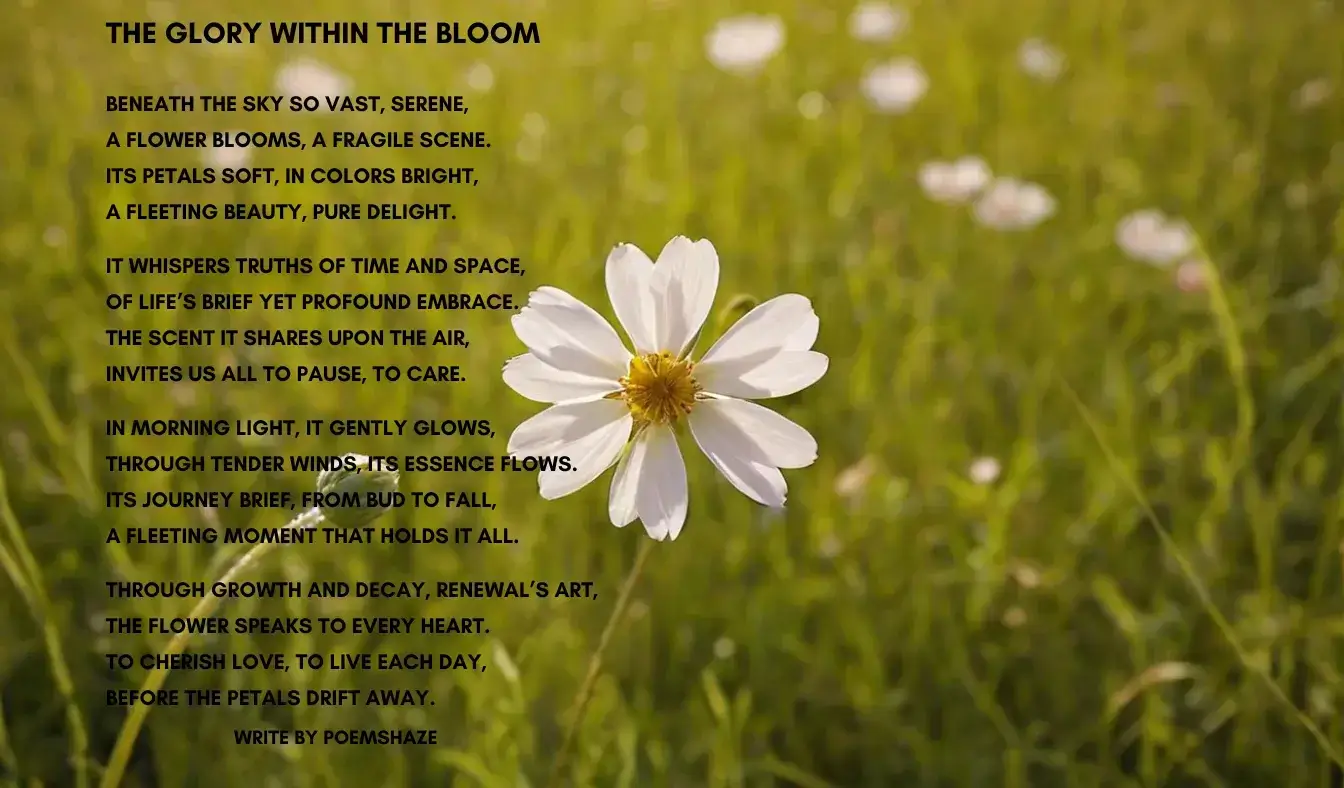
Questions & Answers
Q1: What is the primary theme of the poem “The Glory Within the Bloom”?
A1: The primary theme is the transient nature of life, symbolized by the beauty and impermanence of a flower.
Q2: Why are flowers significant in poetry?
A2: Flowers symbolize universal emotions, fragility, and the passage of time, making them a poignant metaphor for life’s cycles.
The Impermanence of Beauty
Flowers bloom with a fleeting grace, reminding us of the transience of nature and the importance of living in the present moment. Their delicate petals and vibrant hues paint a picture of life’s duality—beauty and decay.
In poetic expressions, flowers symbolize hope, fragility, and renewal. The glory in the flower poem reflects a deep reverence for nature’s ephemeral wonders, inviting us to find joy in the fleeting. As the petals fall, they signify the inevitable decay, yet promise the emergence of new life, echoing the eternal nature’s cycle.
By observing flowers, we gain insight into the human condition. Their temporary spectacle urges us to savor the small joys, recognize the bittersweetness of existence, and find meaning in every moment. Poets often use metaphors and imagery to illustrate the profound truths flowers unveil about life and mortality.
Poem 2: Whisper of Petals
In the quiet of the morning light,
A flower blooms, fragile and bright.
A moment held, then gently fades,
A fleeting beauty the earth has made.
Its vibrant colors catch the eye,
Yet whisper softly, all must die.
Its petals fall, a gentle rain,
Echoing life’s joy and pain.
Within its bloom, a world unfolds,
Of truths unspoken, stories told.
The dance of life, of death, rebirth,
A silent hymn sung by the earth.
Cherish the bloom, embrace its call,
For in its fragility, lies it all.
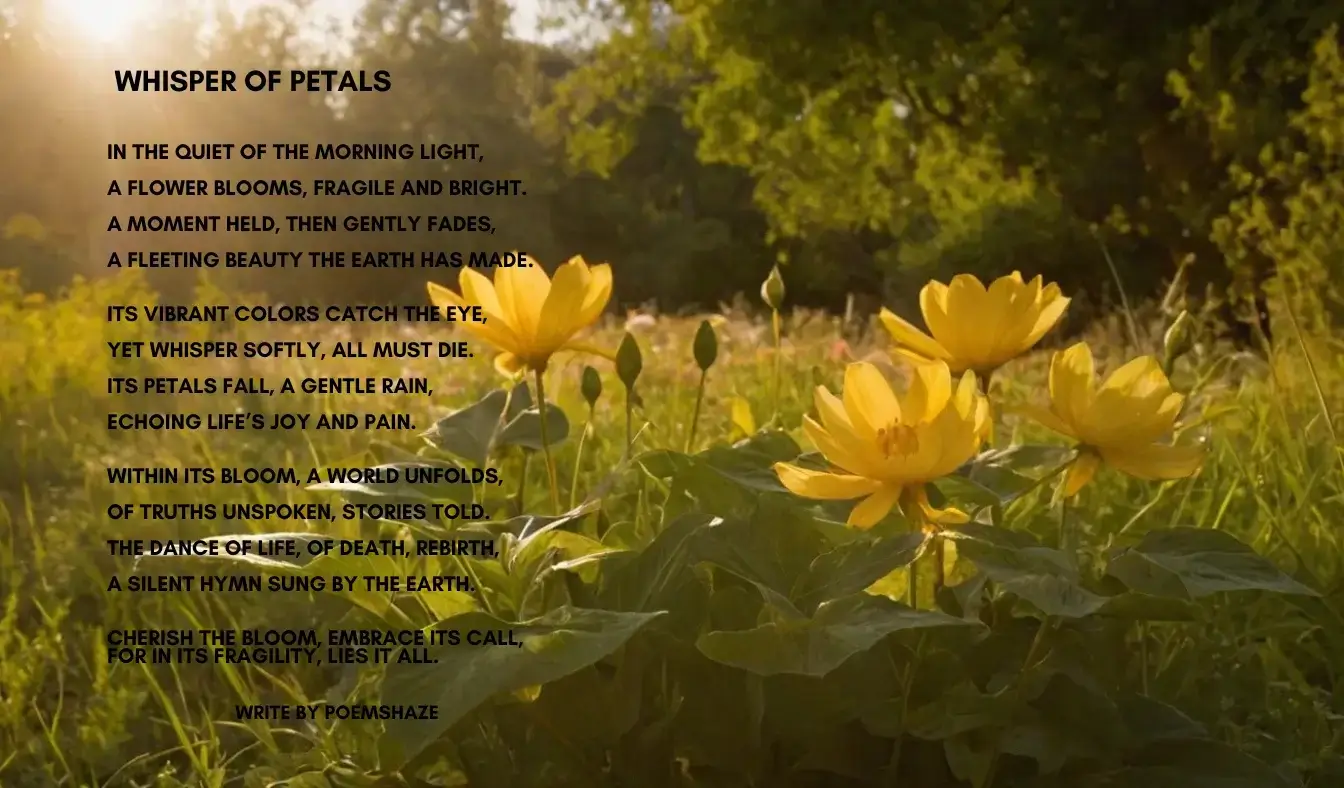
The Symbolism of Flowers in Poetry
Flowers have long been a potent symbol in literature, embodying universal emotions such as love, loss, and renewal. Their presence in poems, like the glory of a flower, connects readers to the profound beauty of existence.
Through their imagery and figurative language, poets explore the duality of life and death. A flower’s delicate petals, kissed by the morning dew, evoke a sense of wonder and awe, while their inevitable wilting reminds us of life’s impermanence.
These metaphors inspire reflection on our place in the world, urging us to find meaning in the fleeting and to celebrate life’s fragility and impermanence. By contemplating flowers, we are reminded of the enduring beauty that lies even in transience.
Poem 3: Eternal Bloom
The bloom unfolds in vibrant hues,
A fleeting gift the earth renews.
Its tender touch, a fragile thread,
Between the living and the dead.
It stands for love, for loss, for light,
A guiding star in darkest night.
A flower’s life, though brief, profound,
Spreads hope and beauty all around.
Through cycles of growth, decay, and birth,
It mirrors the journey of the earth.
A quiet reminder, soft and true,
Life’s greatest glory lies in you.
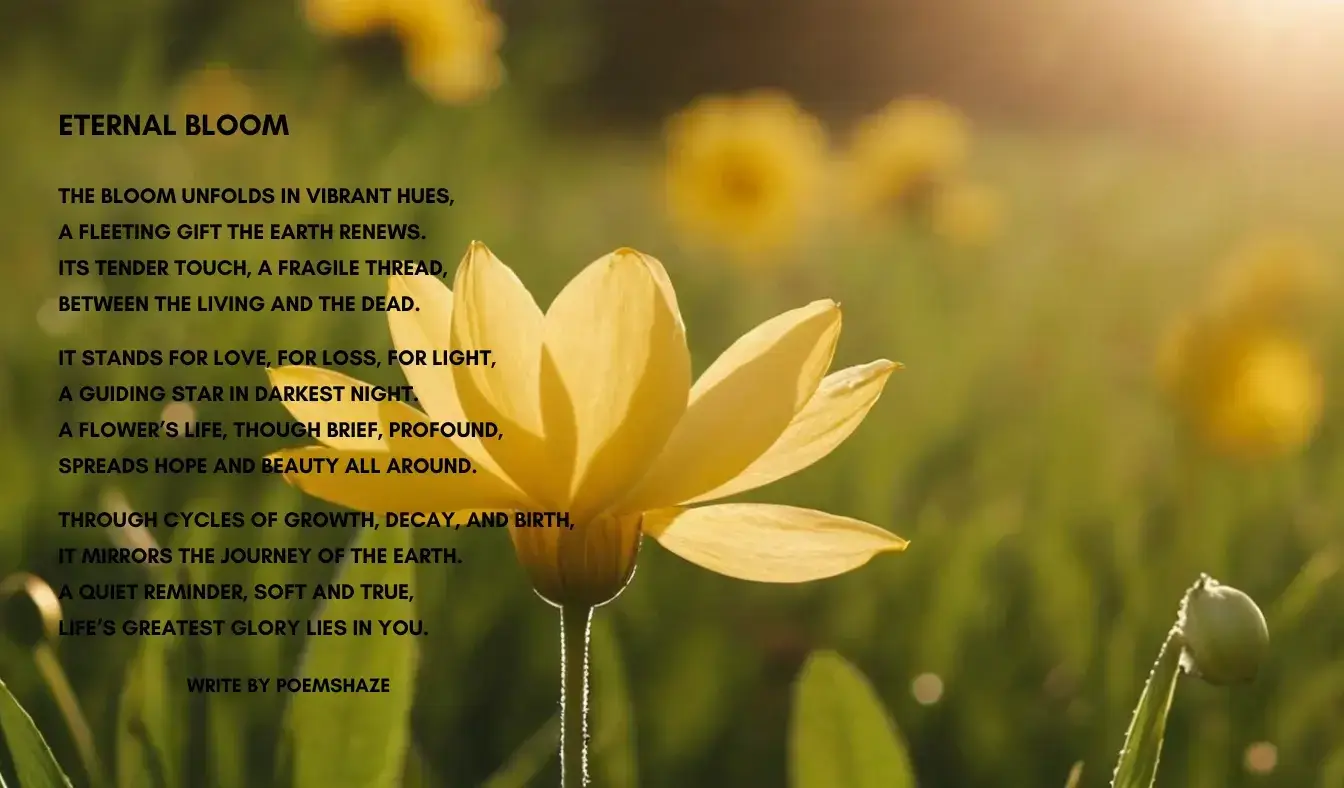
The Dance of Nature’s Palette
Every flower is a brushstroke on nature’s palette, a masterpiece in the making. The symphony of colors found in blooming meadows captures the essence of life’s complexity. The glory in a flower reflects the intricate balance between joy and sorrow, light and dark.
In spring, when morning light kisses the petals, the world is transformed into a canvas of beauty and hope. Each bloom, with its subtle scent and vibrant colors, speaks of renewal and the promise of new beginnings.
Through poetry, flowers remind us of the power of nature to inspire and heal, urging us to find solace and strength amidst life’s ever-changing rhythms.
READ MORE POEMS:
- Poems About Her Strength: Celebrating Women’s Resilience
- Beautiful Poems About Falling in Love Unexpectedly
- I Miss You Poems For Him Long Distance Relationship
Poem 4: Nature’s Symphony
A meadow wakes, in morning’s glow,
A dance of flowers, soft and slow.
Their hues converge, a vibrant stream,
A living, breathing, timeless dream.
The earth, a canvas, paints with grace,
A fleeting beauty time can’t erase.
Each bloom a note, a whispered song,
In nature’s symphony, pure and strong.
Though petals fall and colors fade,
Their spirit lingers, unafraid.
For every ending births a start,
The cycle flows, an eternal heart.
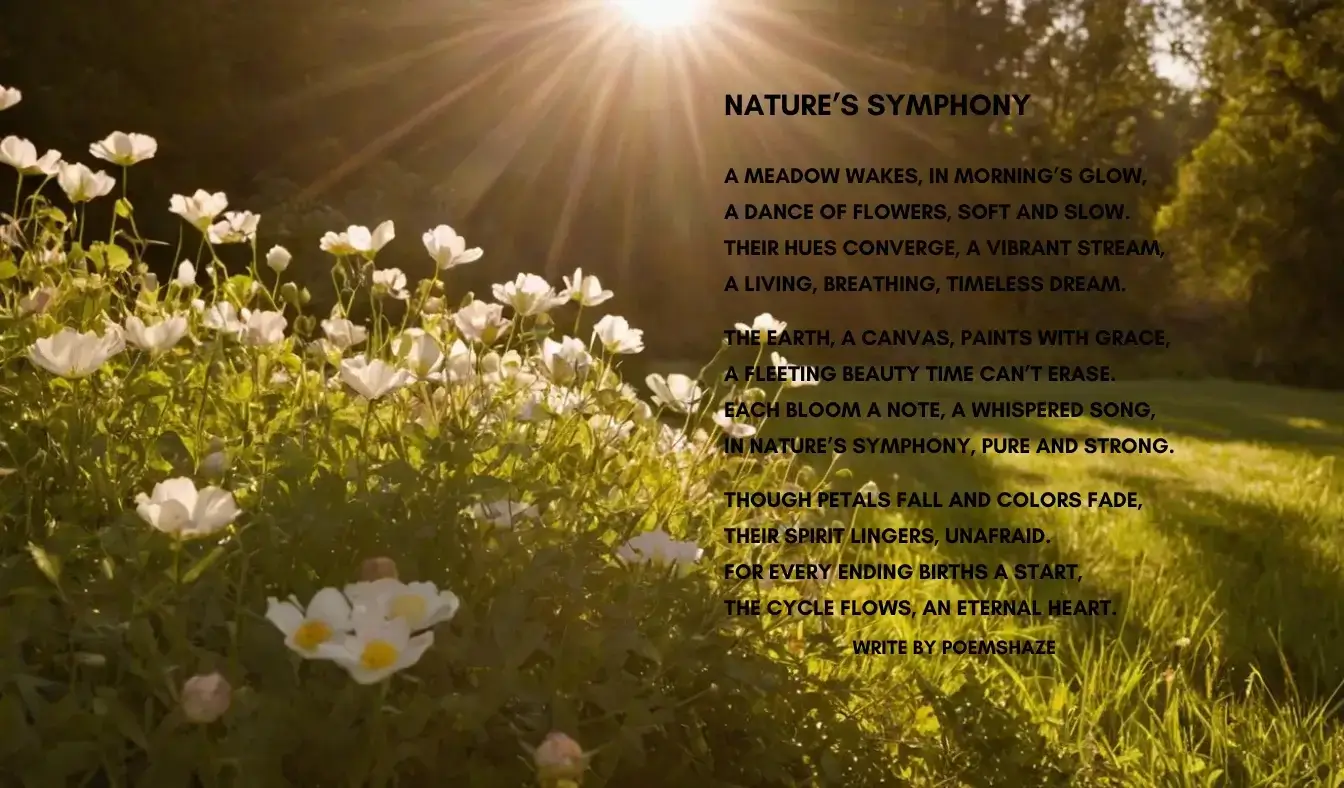
The Fleeting Nature of Beauty
The fleeting beauty of a flower captures the essence of life’s transience. Each bloom, though temporary, leaves a lasting impact—a reminder to cherish the present moment. The glory of the flower poem serves as a metaphor for the impermanence of joy and the inevitability of change.
In its brief existence, a flower teaches us to find meaning and purpose in every passing day. Its delicate petals and subtle scent inspire a profound appreciation for the small yet extraordinary details in life. As we watch a flower bloom and fade, we see the duality of life and death, the bittersweet nature of existence.
Through poetry, the symbolism of flowers reveals the beauty found in impermanence. The cycle of growth, decay, and renewal speaks to the resilience of nature and the enduring power of hope. Each flower becomes a potent symbol of life’s journey—a celebration of what it means to truly live.
Poem 5: Ephemeral Grace
The petals fall as seasons turn,
A fleeting grace we strive to learn.
Its life so brief, its message clear,
To hold each moment close and near.
The flower blooms, then softly fades,
Its beauty etched in sunlit glades.
A cycle endless, rich, profound,
A fleeting joy that knows no bound.
Each bloom a whisper, soft and true,
A call to cherish what we do.
For in the dance of life and death,
The flower finds eternal breath.
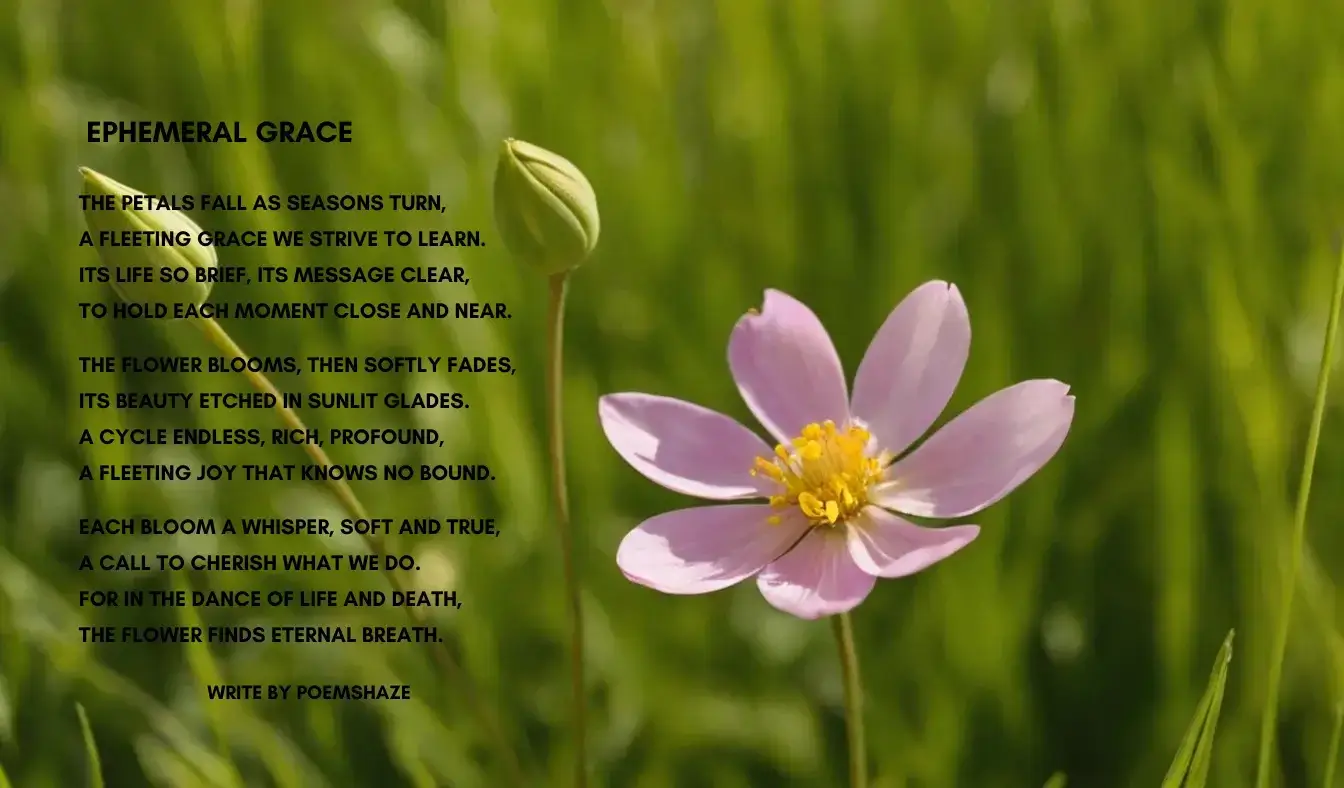
Nature’s Artistry and the Power of Renewal
Nature’s artistry is unparalleled, and flowers are among its finest masterpieces. The glory in the flower poem captures the cycle of renewal, showing how life continues despite the inevitable fall of petals. In every stage of a flower’s journey—from bud to bloom, to wilting and decay—there’s a story of resilience and transformation.
The colors of life displayed in blooming flowers reflect the universal emotions that connect humanity. Their vibrant hues symbolize joy, love, and hope, while their fragile beauty reminds us of life’s delicate balance.
Poets often use flowers as a metaphor for the human experience, showcasing their ability to inspire, heal, and teach. From the first rays of morning light on blooming meadows to the hidden wonders within every petal, flowers offer a profound sense of awe and wonder.
Poem 6: Canvas of Creation
A petal falls, yet life remains,
A masterpiece through joys and pains.
The earth, a canvas vast and wide,
With flowers blooming side by side.
In every hue, a story told,
Of love, of loss, of hearts consoled.
A dance of colors, rich, divine,
A fleeting glimpse of the sublime.
Though petals fade, their beauty stays,
In memories of sunlit days.
The flower whispers, “Do not mourn,
For in my place, new life is born.”
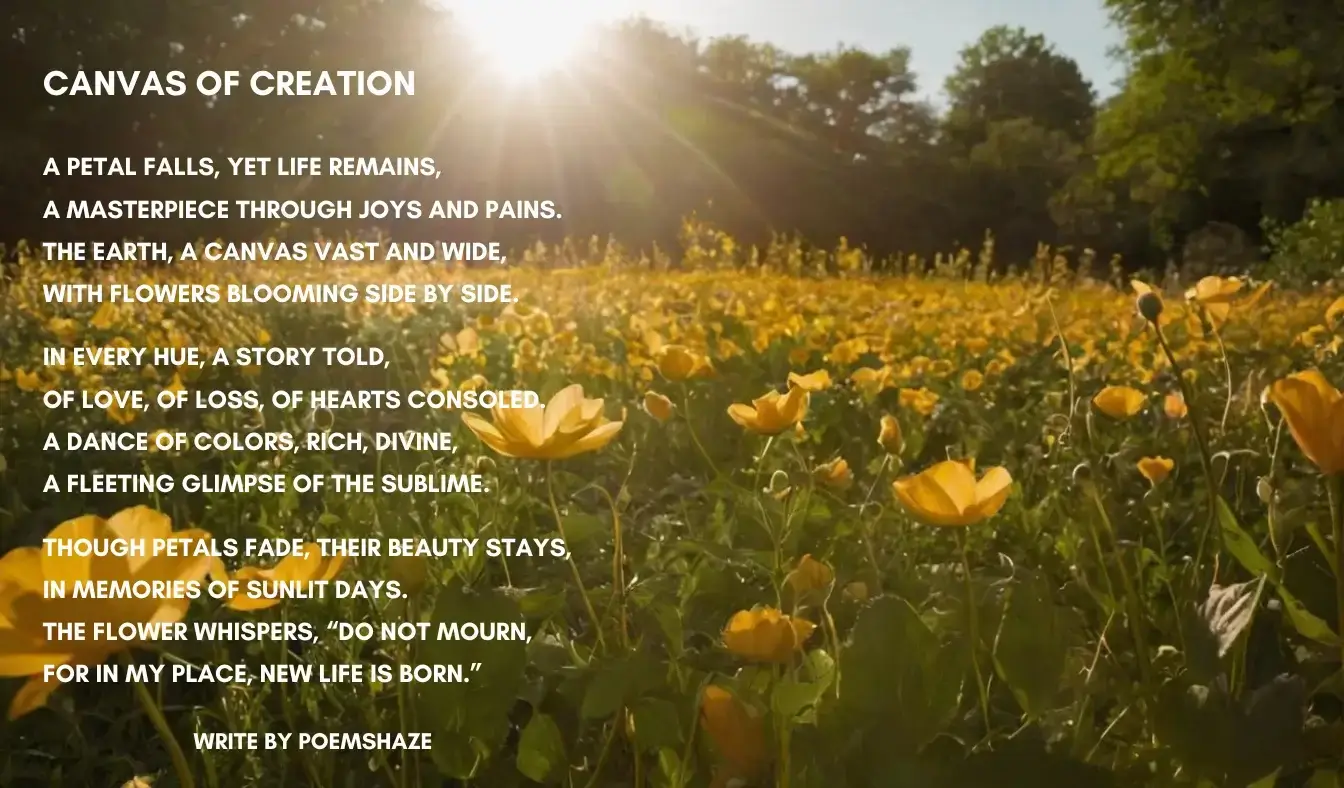
The Human Connection to Flowers
Flowers resonate deeply with the human condition, embodying the fragility and beauty of life. The glory in the flower lies in its ability to evoke emotions that transcend time and place. They remind us of the shared experiences of love, loss, and renewal, connecting us to the universal cycle of existence.
In poetry, flowers are often seen as a reflection of our innermost selves. Their transient nature mirrors the fleeting moments of beauty in our lives, urging us to celebrate even the smallest joys. By observing a flower’s delicate petals and vibrant colors, we are reminded of life’s impermanence and the importance of living with intention.
The poet’s perspective captures the profound connection between flowers and humanity, using them as a symbol of hope, resilience, and renewal. Through their poetry, they inspire us to embrace life’s changes and find peace in its cycles.
Poem 7: The Flower’s Call
A bloom so soft, a voice so clear,
A message whispered year to year.
To love, to hope, to face each day,
Before the petals drift away.
Its colors shine, a fleeting flame,
A gentle touch, a sacred name.
In life, in death, the flower stands,
A quiet guide through shifting sands.
Its story told in every hue,
A truth profound, yet always new.
To live, to grow, to one day fall,
And find renewal through it all.
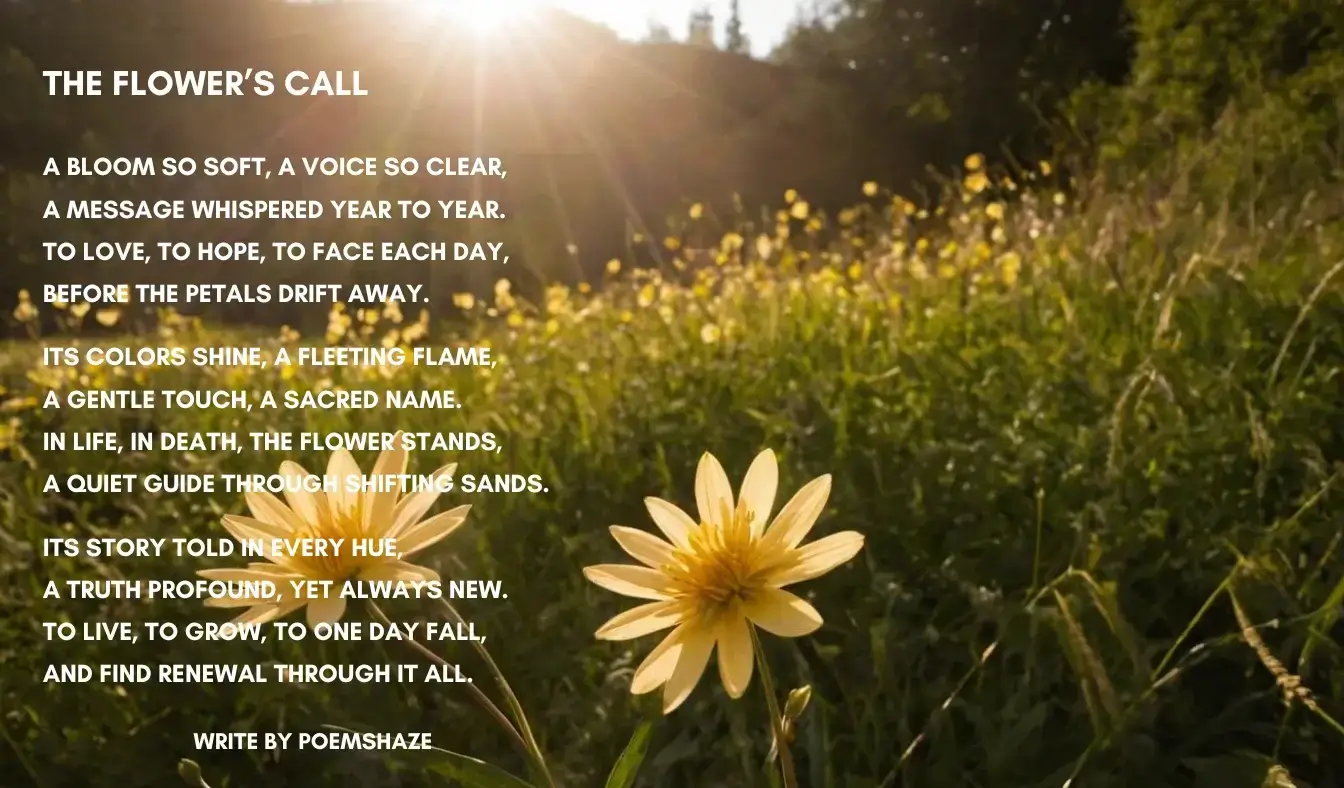
Questions & Answers
Q1: How do flowers reflect the human experience?
A1: Flowers mirror the fragility and beauty of life, teaching us to embrace change and find joy in fleeting moments.
Q2: Why are flowers significant in poetry?
A2: Flowers symbolize universal themes such as love, hope, and mortality, making them a powerful metaphor for the human condition.
Flowers as a Symbol of Life’s Journey
Flowers symbolize the journey of life, portraying its fragility, beauty, and inevitability. Their short-lived bloom reflects the fleeting nature of existence, urging us to appreciate the present moment. The glory in the flower poem beautifully illustrates how every stage of a flower’s life—from its budding promise to its eventual fading—mirrors the cycles of human experience.
The vibrant colors of flowers speak to the joy and vitality found in moments of growth, while their wilting petals remind us of life’s bittersweetness. This symbolism resonates deeply in poetry, offering insights into the human condition. Through metaphors and imagery, flowers convey themes of hope, renewal, and the power of transformation.
In the hands of a poet, a flower becomes more than a natural wonder—it’s a reminder of life’s potential and purpose. By embracing the glory of the flower, we learn to celebrate both its beauty and its impermanence, finding meaning in its fleeting existence.
Poem 8: A Bloom’s Journey
A bud emerges, soft and shy,
Reaching slowly toward the sky.
A burst of life, in vibrant hues,
A fleeting gift the world renews.
The bloom unfolds, a gentle grace,
Its journey etched in time and space.
Each petal whispers, soft and true,
“Life is brief, but beauty’s in you.”
Through summer days and evening light,
It stands in glory, bold and bright.
Yet time will come, as seasons pass,
The petals fall, return to grass.
A cycle spins, through joy and pain,
What fades away will bloom again.
For in its heart, the flower knows,
Through every end, new life still grows.
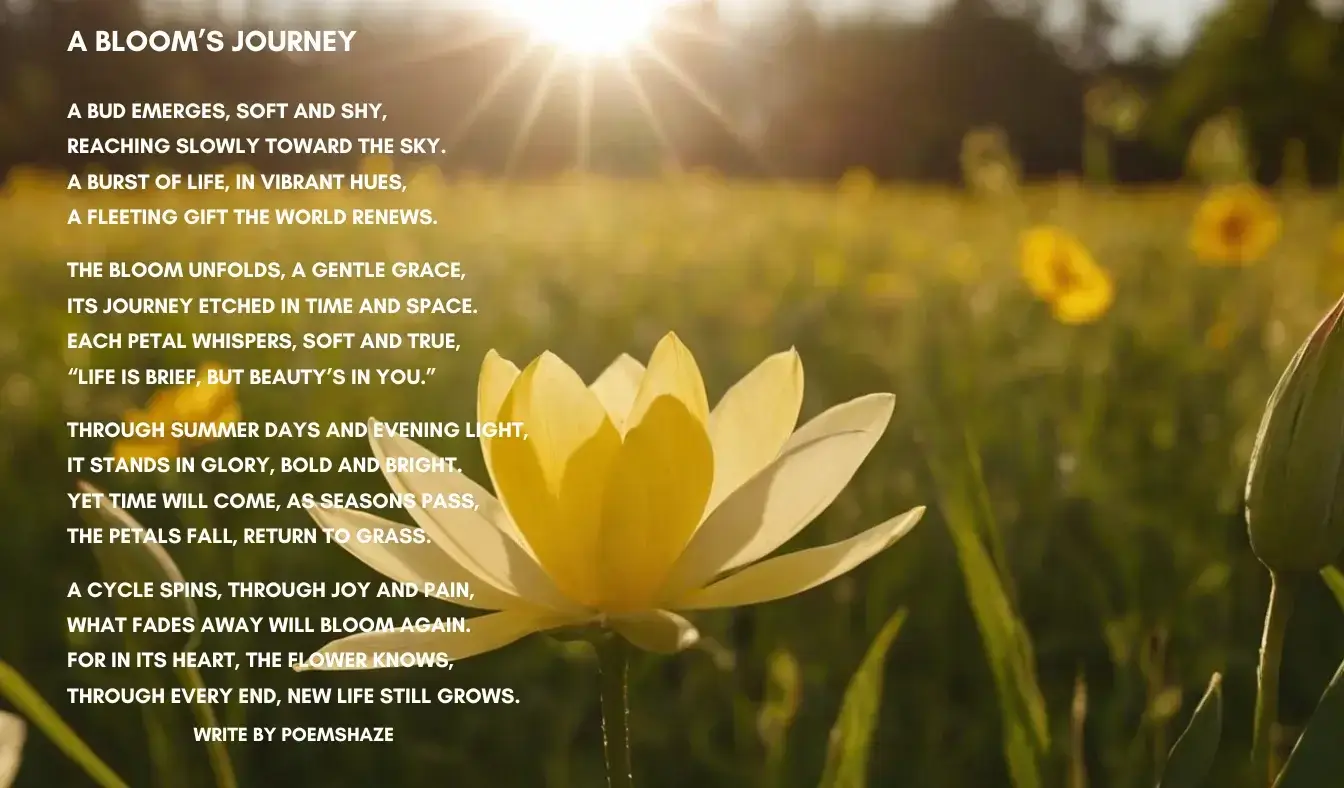
The Role of Flowers in Poetic Expression
Flowers hold a unique place in poetry, serving as metaphors for emotions, relationships, and the passage of time. The glory in a flower poem reveals the depths of human thought, connecting the natural world to the universal emotions we all share.
Through their delicate petals and subtle scents, flowers evoke feelings of awe and wonder. They represent the duality of life—its joy and sorrow, its growth and decay. Poets use these elements to craft imagery that resonates with readers, allowing them to see their own experiences reflected in the beauty of a flower.
Whether symbolizing love, hope, or loss, flowers in poetry remind us of life’s transience and the enduring power of renewal. Their presence in literature encourages contemplation of our place in the world and the fragility of existence, inviting us to find beauty in even the smallest details.
Poem 9: Petals of the Soul
A petal falls, yet love remains,
Its memory etched in joy and pains.
A flower blooms, then fades from view,
A fleeting life, both old and new.
It speaks of love, of hearts once torn,
Of beauty lost, and hope reborn.
A quiet whisper, soft and sweet,
Of life’s short steps, of time’s retreat.
Through every petal, stories rise,
Of fleeting moments, endless skies.
The flower stands, a gentle guide,
Through shifting seasons, far and wide.
Though blooms may fade and colors wane,
Their essence lingers, free from pain.
For every flower, bright or small,
Holds life’s great truths within its call.
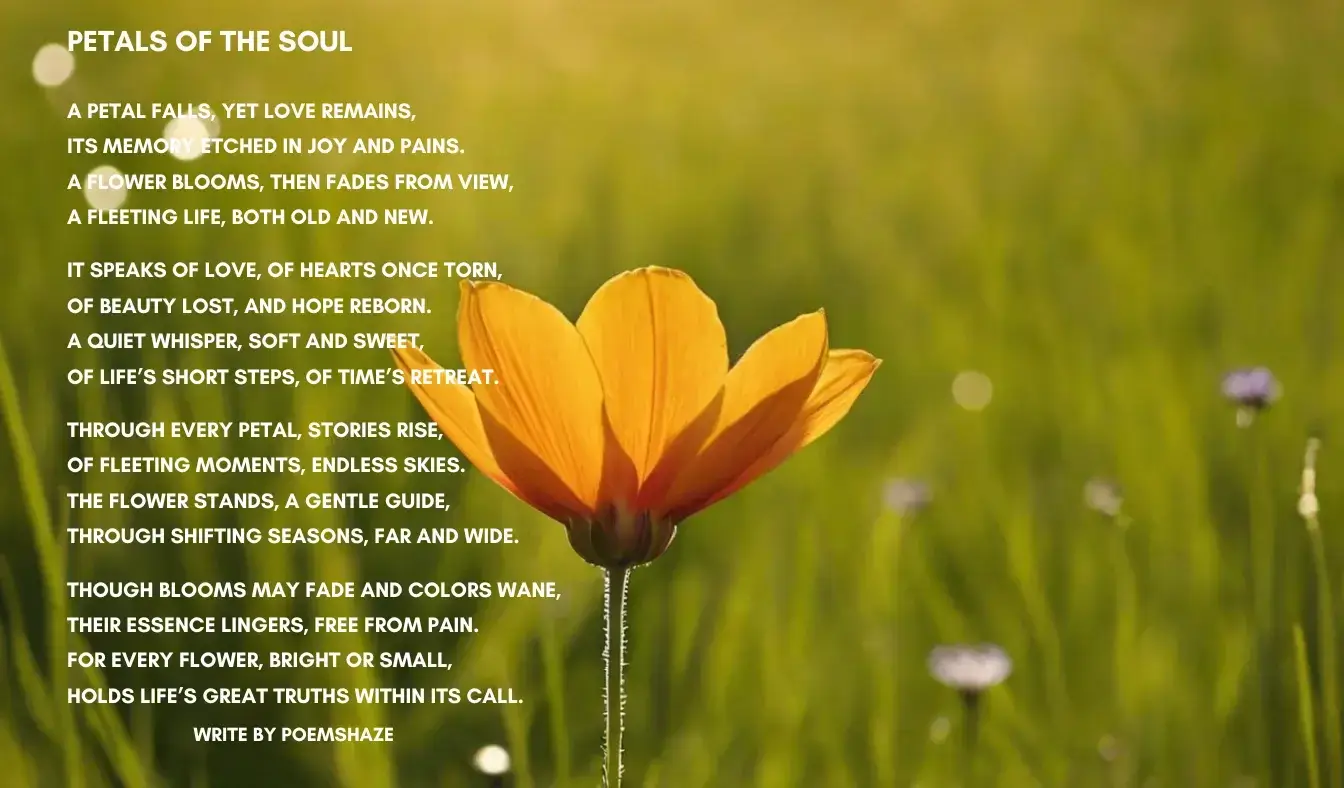
Flowers and the Cycle of Renewal
The glory of a flower poem often highlights the profound role of flowers in the cycle of renewal. From the first bloom of spring to the quiet falling of petals in autumn, flowers embody the essence of transformation. They remind us that every ending brings a new beginning, echoing nature’s promise of resilience.
The process of decay and renewal seen in flowers is a metaphor for life’s challenges and triumphs. Their vibrant colors during peak bloom represent moments of joy and achievement, while their inevitable decay symbolizes the lessons we learn through change.
Poets often turn to flowers to express the duality of hope and loss, finding inspiration in their ability to bloom again despite the passing of seasons. In this way, flowers are a symbol of life, teaching us to embrace the rhythm of nature and find strength in its endless cycle.
Poem 10: The Promise of Petals
The flowers fade, the seasons turn,
Yet deep within, their spirits burn.
A promise made in winter’s chill,
That life will bloom and grow at will.
Each petal falls, a quiet prayer,
A whisper soft, “Renewal’s there.”
Through every loss, a seed takes root,
From withered bloom to tender shoot.
The colors fade, but life persists,
Through trials faced and fleeting bliss.
For every ending starts anew,
A cycle spinning, tried and true.
So let the petals fall with grace,
For in their loss, new blooms find space.
The flower’s journey never ends,
A tale of life that time transcends.
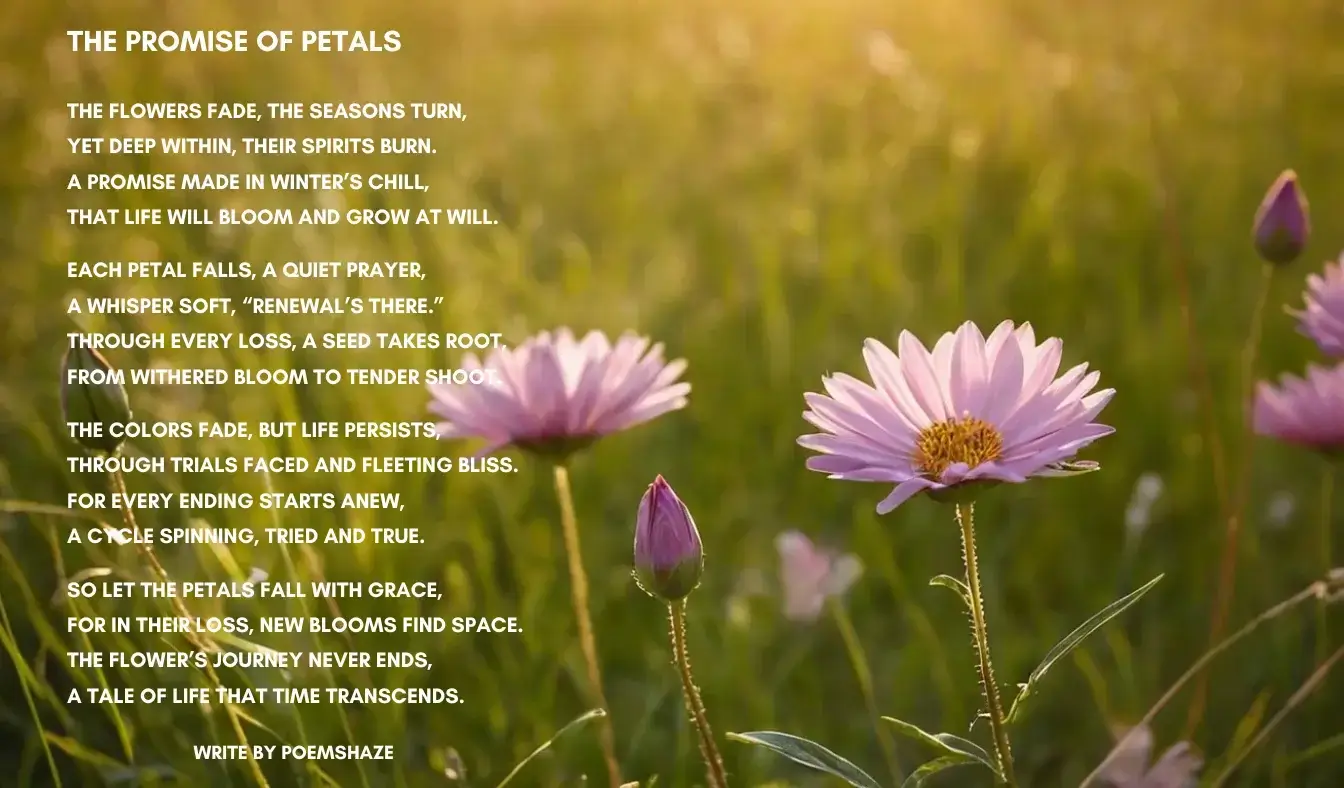
Questions & Answers
Q1: What do flowers symbolize in poetry?
A1: Flowers symbolize themes such as life, love, loss, and renewal, reflecting the cycle of existence and the beauty of impermanence.
Q2: How do poets use flowers in their work?
A2: Poets use flowers as metaphors and imagery to explore universal emotions, the passage of time, and the delicate balance between joy and sorrow.
The Delicate Balance Between Joy and Sorrow
Flowers teach us the delicate interplay between joy and sorrow, their fleeting beauty a testament to life’s impermanence. The glory in a flower poem captures this poignant balance, where each bloom represents a celebration of life, even as it anticipates its inevitable end.
The contrast of vibrant colors against the shadow of decay mirrors the duality of the human experience. Flowers remind us that growth and renewal often come through moments of pain and transformation. Their brief existence calls us to cherish life’s transient joys while finding strength in adversity.
Poets often use flowers as a lens through which to explore these universal truths. Through imagery and metaphors, flowers symbolize both the fleeting nature of happiness and the enduring hope of renewal. Their ability to inspire awe reflects the profound beauty in life’s bittersweet moments, teaching us to embrace every bloom, however brief.
Poem 11: Petals of Joy and Sorrow
Beneath the sky of endless blue,
A flower blooms, its soul in view.
Its colors shine, a radiant light,
Yet shadows linger, soft and slight.
Each petal tells a tale of grace,
Of fleeting moments time can’t erase.
Through joy it sings, through tears it weeps,
A fragile balance nature keeps.
Its dance is brief, its beauty rare,
A whispered truth, “Life’s never fair.”
Yet in its fall, it softly speaks,
Of hope reborn through life’s techniques.
Though sorrow comes, the joy remains,
A cycle spun through sun and rains.
The flower stands, both weak and strong,
A fleeting note in nature’s song.
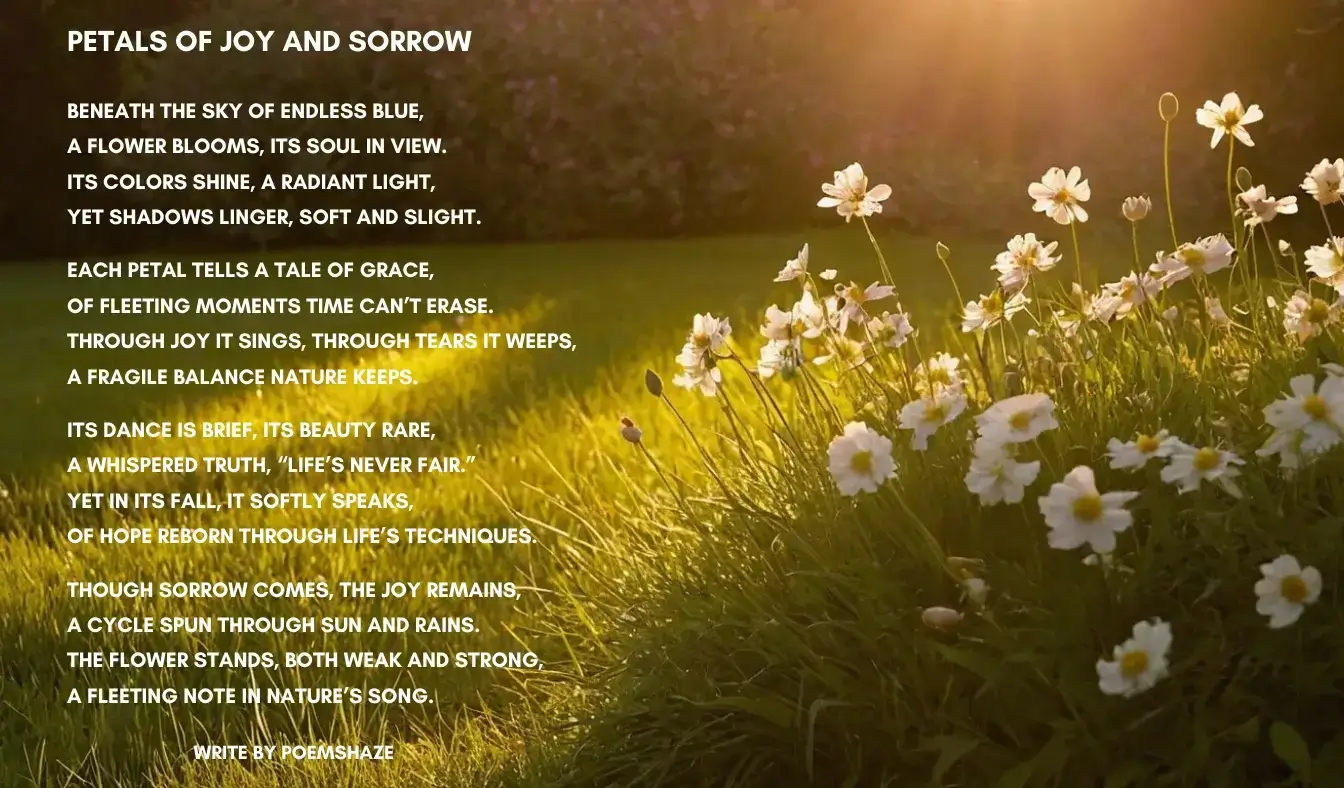
Finding Meaning in the Transience of Flowers
The transience of flowers reflects the impermanence of all things, offering a lesson in finding beauty and meaning in the moment. The glory of a flower poem often focuses on the fleeting nature of blossoms, using their delicate petals as a metaphor for the preciousness of time.
Each flower’s journey—from its vibrant bloom to its quiet wilting—symbolizes the passage of time and the inevitable changes we face. This transient nature teaches us to cherish life’s moments and find gratitude in their brevity.
Poets embrace this symbolism to connect readers to the human condition, illustrating how flowers serve as reminders to live fully and authentically. By observing the life cycle of a flower, we see the resilience of nature and the promise of renewal that follows even the darkest winters.
Poem 12: Transient Wonders
A bloom appears, its life a spark,
A fleeting flame against the dark.
Its petals soft, its colors bright,
A moment’s glory, pure delight.
It does not linger, cannot stay,
Its beauty lives, then fades away.
Yet in its passing, whispers still,
“Each fleeting moment shapes your will.”
The morning light, the evening fall,
The flower speaks to one and all.
To cherish time, to live each day,
Before the petals drift away.
Through seasons swift, its truth remains,
A fleeting joy through life’s terrains.
For in its heart, we come to see,
The fragile gift of memory.
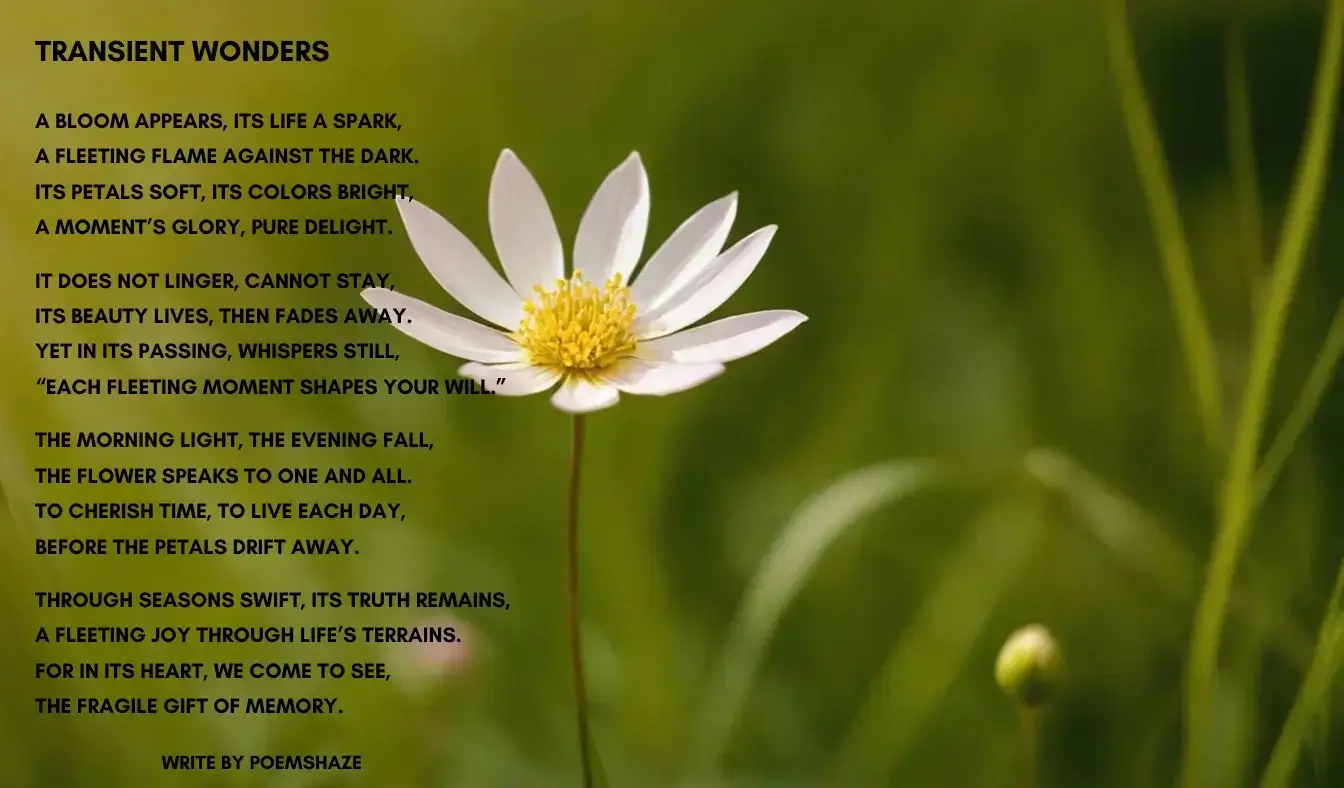
The Universality of Flowers in Poetry
Flowers transcend cultural and temporal boundaries, serving as a universal symbol in poetry. The glory of the flower lies in its ability to evoke emotions and connect us to the shared experiences of love, loss, and renewal.
Their presence in poems symbolizes the human condition, capturing the joys and sorrows of life in their fleeting existence. From the vibrant hues of spring blooms to the gentle decay of petals in autumn, flowers reflect the complexity and depth of our own journeys.
Poets use the symbolism of flowers to explore themes of resilience, transformation, and the enduring power of hope. By contemplating their beauty, we find solace in the reminder that even in impermanence, there is purpose and meaning.
Poem 13: The Universal Bloom
A flower blooms in every heart,
A universal work of art.
Its beauty speaks in every tongue,
A song of life forever sung.
From petal soft to vibrant hue,
It mirrors love, both old and new.
A fleeting gift, a transient flame,
Yet every soul will know its name.
Through time it blooms, through time it fades,
A gentle truth in sunlit glades.
Its cycle spins, its story flows,
Through every end, a new one grows.
The flower’s voice, both soft and strong,
Reminds us life is brief, but long.
In fleeting moments, meaning lies,
A bloom eternal, never dies.
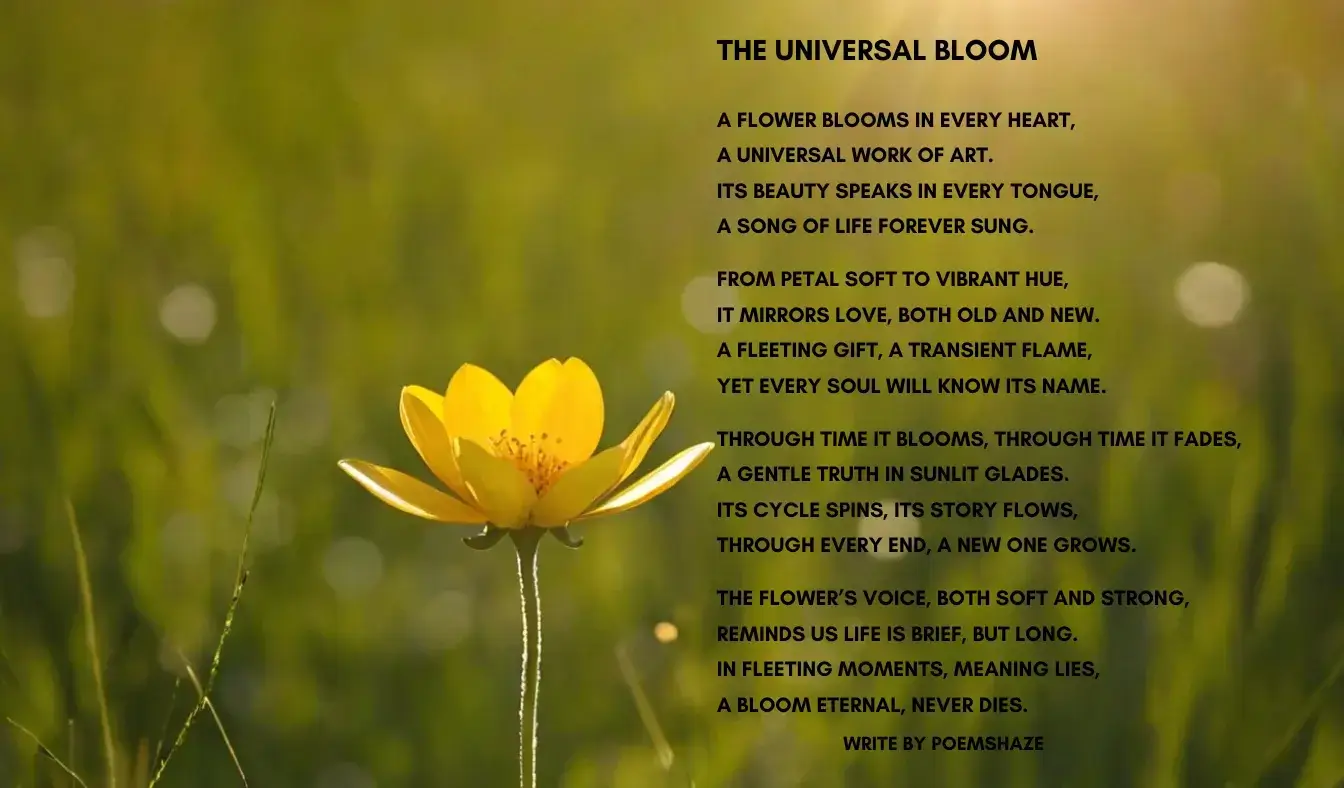
Questions & Answers
Q1: What role do flowers play in poetry?
A1: Flowers serve as metaphors for universal emotions and experiences, symbolizing themes of life, transience, and renewal.
Q2: How do flowers inspire poets?
A2: Flowers inspire poets by reflecting the duality of life and death, their fleeting beauty offering profound insights into the human condition.
READ MORE POEMS:
- Empowering Strong Woman Poem: Celebrating Resilience & Grace
- Handsome Good Morning Poem for Boyfriend: Romance and love
- You Are an Amazing Woman Poem: Strength and Grace
The Glory of Flowers in Morning Light
The morning light transforms flowers into radiant symbols of hope and renewal. As sunlight kisses their delicate petals, their vibrant colors come alive, reminding us of the endless possibilities each day holds. The glory in a flower poem captures this moment of awakening, where nature’s beauty serves as an invitation to embrace life’s opportunities.
In poetry, the glory of the flower is often intertwined with themes of growth, hope, and new beginnings. The fleeting beauty of flowers inspires reflection on the human condition, teaching us to find joy in the present. Each petal, bathed in sunlight, becomes a testament to the resilience of life.
The symbolism of flowers in morning light encourages us to seek the magic in everyday moments. Whether it’s the first bloom of spring or a meadow alive with color, flowers show us that even in impermanence, there is beauty to be celebrated.
Poem 14: Morning’s Glory
In dawn’s embrace, the flowers wake,
A fleeting breath the heavens take.
Their vibrant hues, a gentle fire,
A whispered hymn, a soft desire.
Each petal glows, a fleeting grace,
A mirror of life’s tender pace.
The morning light, so pure, so bright,
Transforms the bloom in its soft light.
Through time, the flower stands so still,
Yet whispers of life’s boundless will.
A fleeting joy, a transient song,
That urges hearts to move along.
Though petals fall as daylight fades,
Their beauty lingers in sunlit glades.
A moment’s glory, bold and true,
A bloom of life for me and you.
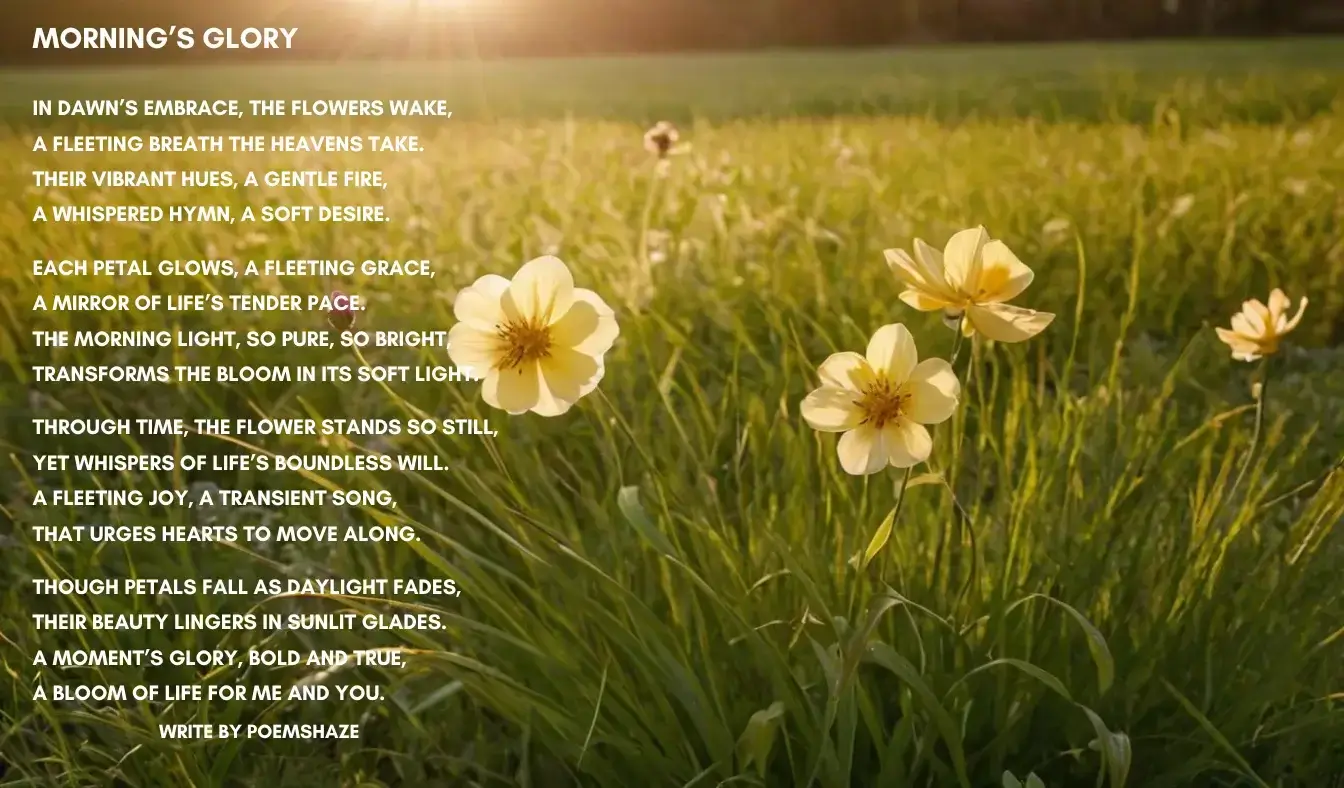
Flowers and the Cycles of Change
Flowers are a profound reminder of life’s cycles of change. Their delicate petals symbolize the fleeting beauty of youth, while their eventual wilting speaks to the inevitability of growth and transformation. The glory in the flower poem celebrates this cycle, illustrating how every ending is also a beginning.
Through their vibrant colors, flowers reflect the highs and lows of existence—the joy of blooming and the bittersweetness of fading. This symbolism resonates deeply in poetry, where flowers become metaphors for resilience, hope, and the enduring power of renewal.
Poets often use imagery and figurative language to explore the lessons flowers teach about life’s impermanence. They encourage us to embrace change as a natural part of the human experience, finding beauty and strength in the process.
Poem 15: The Cycle of Bloom
A seed takes root in soil’s embrace,
A silent promise time won’t erase.
Through rain and sun, it starts to rise,
A bloom emerges beneath the skies.
Its petals soft, its colors bright,
A fleeting moment of pure delight.
Yet even as its beauty fades,
The seedling’s purpose never sways.
For in its fall, new life is born,
A tender sprout in spring’s first morn.
The flower’s truth, so bold, so clear,
Life’s cycles turn through every year.
Though change may come, though blooms may wane,
Their beauty lingers, free from pain.
For every flower, bright or small,
Holds nature’s wisdom in its call.
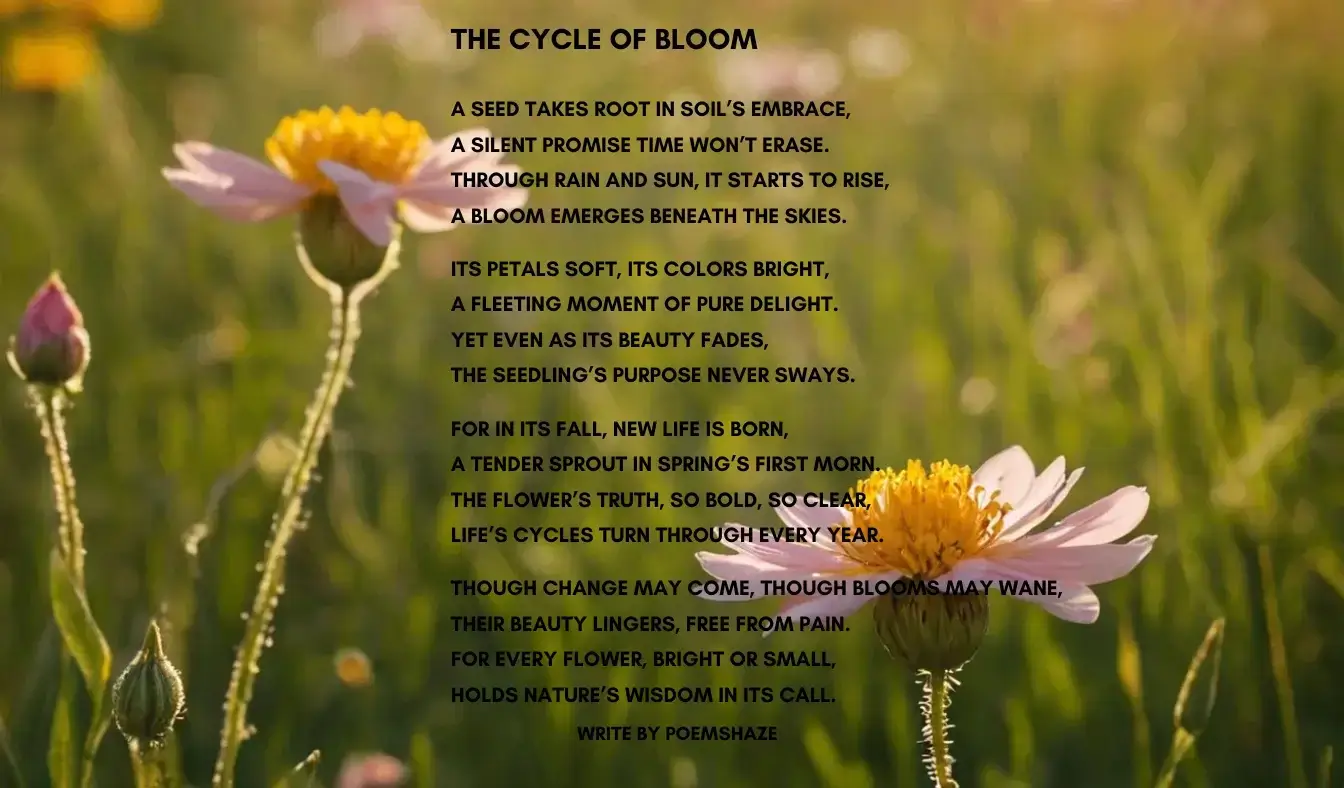
Flowers: A Reflection of Life’s Fragile Balance
The glory of flowers captures the essence of life’s fragility and splendor, serving as a profound metaphor for the human journey. As blossoms unfold in the tender embrace of morning light, they mirror the cycles of existence—growth, decay, and renewal. Their transient beauty urges us to savor fleeting moments and cherish the delicate balance between joy and sorrow.
In poetry, flowers become more than nature’s adornments—they embody resilience and the inevitability of change. The vibrant colors of petals, kissed by sunlight, symbolize the peaks of life’s experiences, while their gentle wilting represents the bittersweet passage of time. The “cycle of bloom” described in The Glory of Flowers reminds us that every ending seeds the promise of new beginnings, a testament to nature’s enduring vitality.
The metaphor of flowers inspires a deeper connection to the universal truths of impermanence. Their fleeting existence encourages us to embrace change and discover beauty in transformation. Whether symbolizing love, loss, or hope, flowers offer a poetic reflection of our shared humanity, inviting us to find meaning in the rhythm of life and the ephemeral moments that define our journey.
Questions & Answers
Q1: What do flowers symbolize in the cycle of life?
A1: Flowers symbolize the cycle of growth, decay, and renewal, illustrating how life continues through transformation.
Q2: How does morning light enhance the beauty of flowers?
A2: Morning light highlights the vibrant colors and delicate details of flowers, inspiring a sense of awe and wonder in their fleeting beauty.

